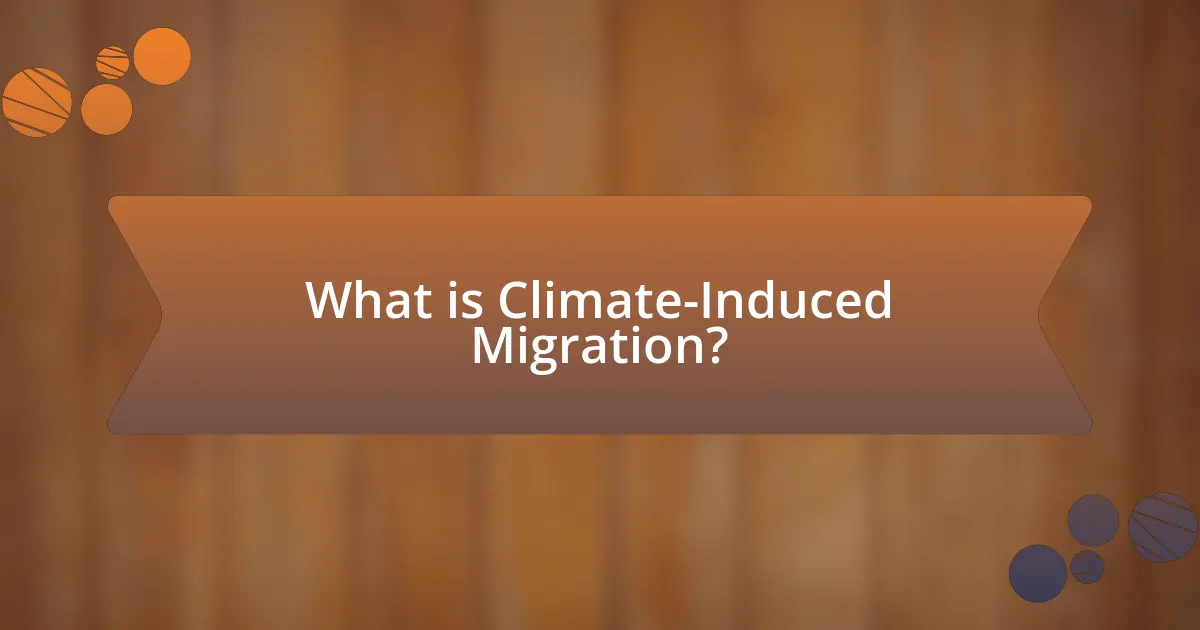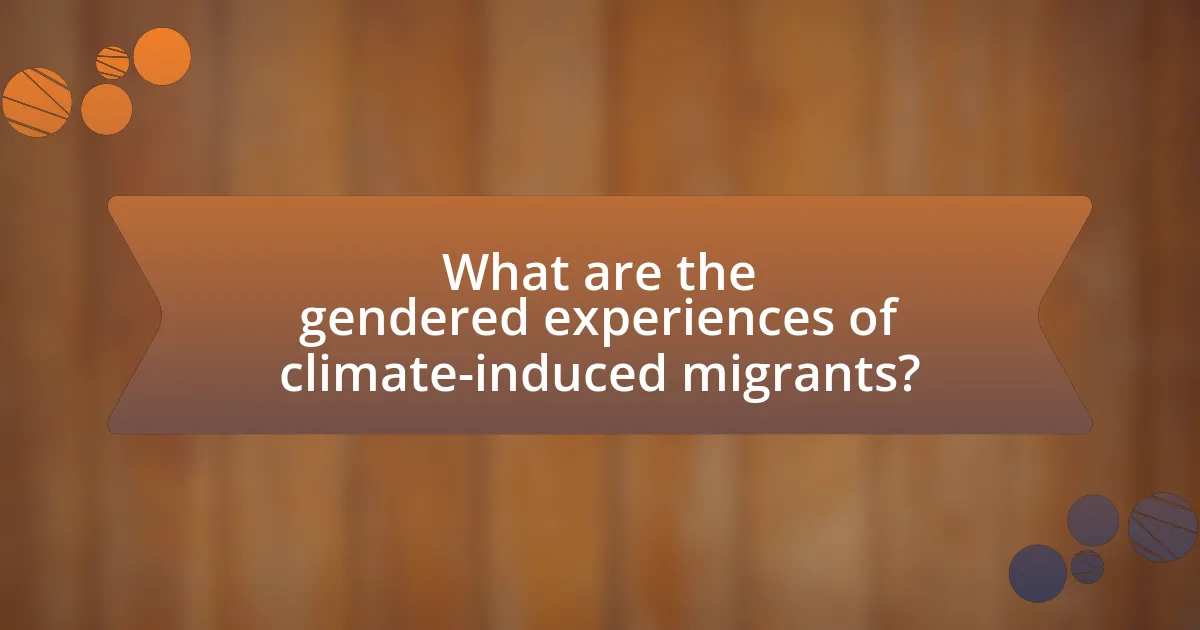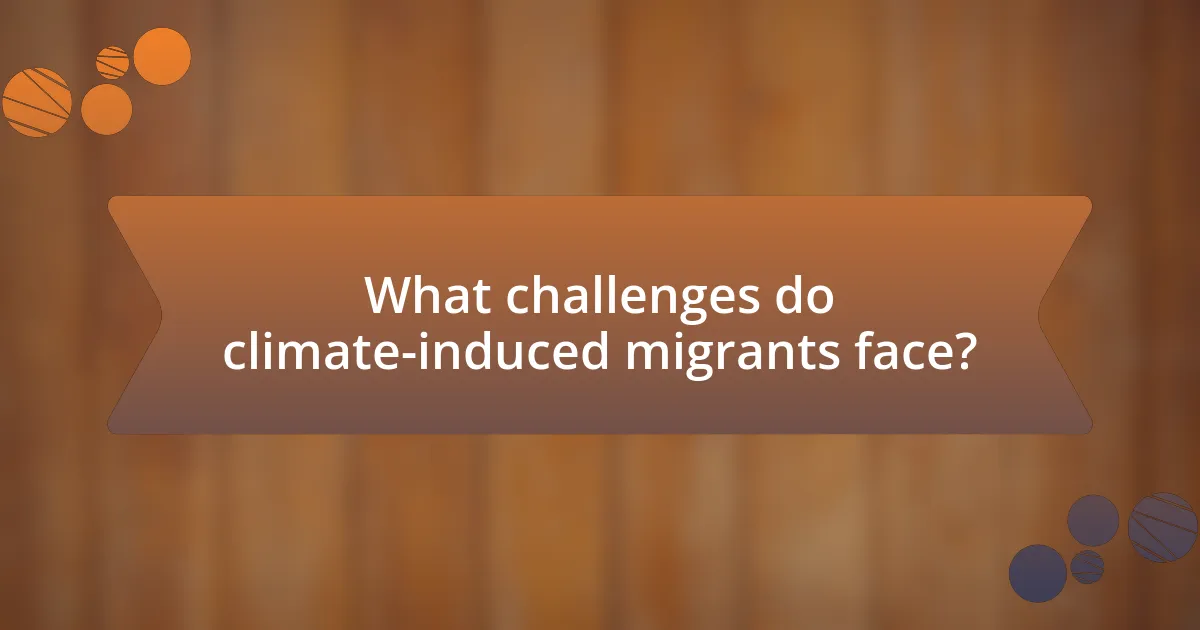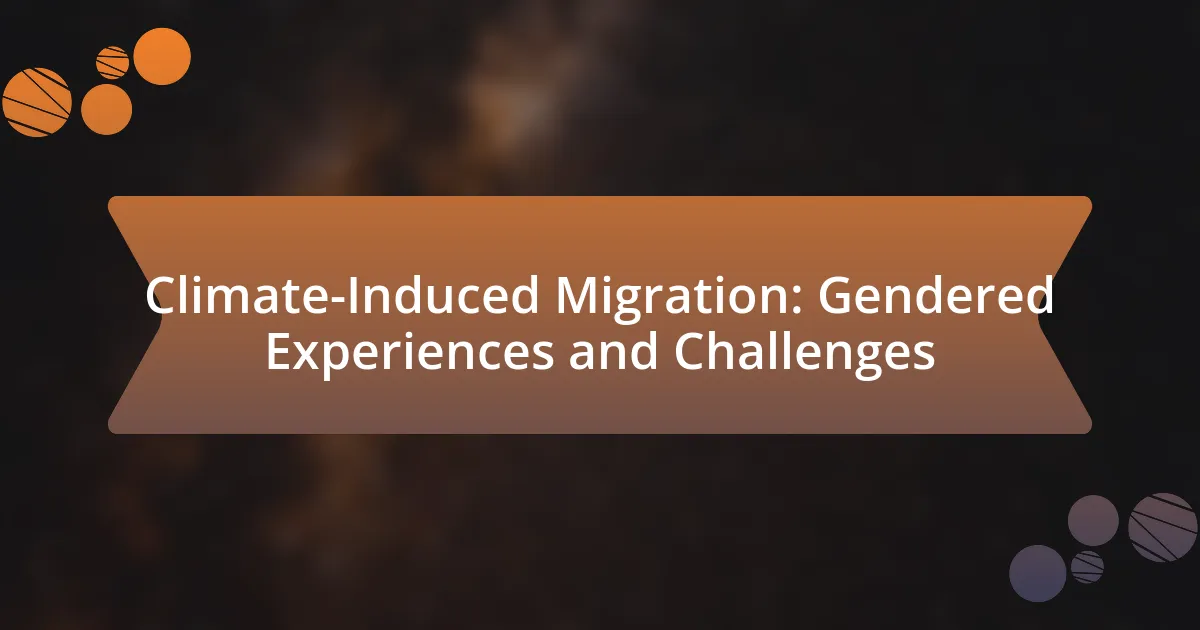Climate-induced migration refers to the displacement of individuals or groups due to environmental changes driven by climate change, such as rising sea levels and extreme weather events. This article examines the significant impact of climate change on global migration patterns, highlighting that by 2050, up to 200 million people may be forced to migrate. It explores the unique challenges faced by climate-induced migrants, particularly women and marginalized communities, who experience heightened vulnerabilities during displacement. The article also discusses the socio-economic challenges, gender-specific issues, and the role of legal frameworks in shaping the experiences of these migrants, emphasizing the need for targeted policies and community-based approaches to support their resilience and integration.

What is Climate-Induced Migration?
Climate-induced migration refers to the movement of individuals or groups forced to leave their homes due to environmental changes caused by climate change, such as rising sea levels, extreme weather events, and prolonged droughts. This phenomenon is increasingly recognized as a significant factor influencing global migration patterns, with the United Nations estimating that by 2050, up to 200 million people could be displaced due to climate-related factors. The impacts of climate-induced migration are often gendered, as women and marginalized communities face unique challenges and vulnerabilities during displacement, including limited access to resources and decision-making power.
How does climate change drive migration patterns?
Climate change drives migration patterns primarily by creating environmental conditions that render certain areas uninhabitable. For instance, rising sea levels, extreme weather events, and prolonged droughts force communities to relocate in search of safer and more sustainable living conditions. According to the Intergovernmental Panel on Climate Change (IPCC), millions of people are expected to be displaced due to climate-related factors, with projections estimating that by 2050, over 200 million individuals could be forced to migrate within their countries as a direct result of climate change impacts. This evidence underscores the significant role climate change plays in shaping migration trends globally.
What specific climate events contribute to migration?
Specific climate events that contribute to migration include extreme weather events, such as hurricanes, floods, droughts, and rising sea levels. These events disrupt livelihoods, destroy homes, and create unsafe living conditions, prompting individuals and communities to relocate. For instance, the 2010 earthquake in Haiti, exacerbated by deforestation and poor infrastructure, led to significant internal and external migration as people sought safety and stability. Additionally, the Intergovernmental Panel on Climate Change (IPCC) reports that climate change is expected to increase the frequency and intensity of such events, further driving migration patterns globally.
How do environmental changes impact livelihoods?
Environmental changes significantly impact livelihoods by altering resource availability, economic stability, and social structures. For instance, climate change can lead to decreased agricultural productivity due to altered rainfall patterns and increased temperatures, which directly affects food security and income for farming communities. According to the Intergovernmental Panel on Climate Change (IPCC), climate change could reduce crop yields by up to 25% in some regions by 2050, exacerbating poverty and forcing communities to migrate in search of better opportunities. Additionally, environmental changes can disrupt traditional livelihoods, such as fishing and forestry, leading to increased competition for dwindling resources and heightened social tensions.
What are the demographics of climate-induced migrants?
Climate-induced migrants predominantly include individuals from vulnerable populations, particularly in developing countries. Research indicates that women, children, and the elderly are disproportionately affected, with women making up approximately 60% of climate-induced migrants in certain regions. Additionally, these migrants often originate from rural areas where livelihoods are heavily dependent on climate-sensitive resources, such as agriculture and fishing. According to the Internal Displacement Monitoring Centre, over 30 million people were displaced by climate-related disasters in 2020 alone, highlighting the urgent need to address the demographic trends associated with climate-induced migration.
How does gender influence migration decisions?
Gender significantly influences migration decisions by shaping the motivations, experiences, and outcomes of individuals. Women often migrate for family reunification, economic opportunities, or to escape gender-based violence, while men may migrate primarily for work or economic advancement. Research indicates that women are more likely to be affected by climate change due to their roles in household management and resource allocation, which can lead to increased migration as they seek safer environments. For instance, a study by the United Nations Development Programme highlights that women in vulnerable communities are disproportionately impacted by climate-induced disasters, prompting them to migrate to ensure their families’ survival and well-being.
What age groups are most affected by climate-induced migration?
The age groups most affected by climate-induced migration are children and young adults, particularly those aged 0-24. This demographic is vulnerable due to their dependence on caregivers and their limited ability to adapt to changing environments. According to the United Nations, children represent a significant portion of the displaced population, with estimates indicating that over 30 million children are currently affected by climate-related displacement. Young adults, aged 18-24, also face challenges as they seek education and employment opportunities in new locations, often exacerbated by the impacts of climate change on their home regions.

What are the gendered experiences of climate-induced migrants?
Gendered experiences of climate-induced migrants vary significantly, with women often facing heightened vulnerabilities compared to men. Women are more likely to experience economic instability, as they typically have less access to resources and decision-making power, which exacerbates their challenges during displacement. For instance, a study by the United Nations High Commissioner for Refugees (UNHCR) highlights that women and girls are at increased risk of gender-based violence in migration contexts, particularly in overcrowded shelters or refugee camps. Additionally, women often bear the brunt of caregiving responsibilities, which can limit their mobility and access to opportunities for recovery and adaptation. This gender disparity is further emphasized by the fact that women are frequently excluded from formal migration policies and disaster response strategies, leading to inadequate support tailored to their specific needs.
How do women experience migration differently than men?
Women experience migration differently than men primarily due to gender-specific vulnerabilities and roles. Women often face increased risks of violence, exploitation, and discrimination during migration processes, which are exacerbated by socio-economic factors and cultural norms. For instance, a study by the International Organization for Migration highlights that women are more likely to be subjected to human trafficking and sexual violence during migration, particularly in conflict or disaster-affected areas. Additionally, women frequently bear the responsibility for caregiving and household management, which can limit their mobility and access to resources compared to men. These gendered experiences are critical in understanding the broader implications of climate-induced migration, as they influence women’s ability to adapt and recover from environmental changes.
What unique challenges do women face during migration?
Women face unique challenges during migration, particularly in the context of climate-induced displacement. These challenges include increased vulnerability to gender-based violence, limited access to resources and services, and the burden of caregiving responsibilities. For instance, a report by the United Nations High Commissioner for Refugees (UNHCR) highlights that women and girls are at a heightened risk of sexual exploitation and trafficking during migration, especially in crisis situations. Additionally, women often encounter barriers in accessing healthcare, education, and employment opportunities, which are exacerbated by cultural norms and legal restrictions in host countries. The International Organization for Migration (IOM) notes that these factors can lead to economic instability and social marginalization for migrant women, further complicating their migration experience.
How do cultural norms affect women’s migration experiences?
Cultural norms significantly shape women’s migration experiences by influencing their decision-making, mobility, and integration processes. In many societies, traditional gender roles dictate that women have limited autonomy, which can restrict their ability to migrate independently. For instance, in regions where patriarchal structures prevail, women may face familial or societal pressure to remain in their home communities, even in the face of climate-induced displacement. Research indicates that women are often expected to prioritize family responsibilities over personal aspirations, which can hinder their migration opportunities. Furthermore, cultural perceptions of women’s safety and honor can lead to increased scrutiny and restrictions on their movement, impacting their access to resources and support networks in destination areas. Studies show that women who do migrate often encounter challenges related to discrimination and lack of access to services, which are exacerbated by prevailing cultural attitudes towards gender.
What role do men play in climate-induced migration?
Men play a significant role in climate-induced migration as primary decision-makers and economic providers for their families. In many cultures, men are often responsible for assessing risks and determining whether to migrate in response to environmental changes, such as droughts or floods. This decision-making is influenced by their roles in traditional gender norms, where they prioritize family survival and economic stability.
Research indicates that men are more likely to migrate first to secure resources and establish a new livelihood before their families follow. For instance, a study by the International Organization for Migration highlights that men often migrate to urban areas for work opportunities created by climate change, which can lead to a shift in family dynamics and responsibilities. This migration pattern can result in increased vulnerability for women and children left behind, as they may face additional challenges in accessing resources and support.
How do men’s migration experiences differ from women’s?
Men’s migration experiences often differ from women’s due to varying social roles, economic opportunities, and safety concerns. Men typically migrate for employment opportunities, driven by economic necessity, while women may migrate for family reunification or to escape gender-based violence. Research indicates that women face greater risks during migration, including higher vulnerability to trafficking and exploitation, as highlighted in the report “Gender and Climate Change: Evidence and Experience” by the United Nations Framework Convention on Climate Change. Additionally, cultural norms often restrict women’s mobility, making their migration experiences more complex and challenging compared to men.
What responsibilities do men take on during the migration process?
Men take on various responsibilities during the migration process, including financial provision, logistical planning, and family protection. Specifically, men often serve as the primary breadwinners, securing resources necessary for the journey and settlement in a new location. They also handle the organization of travel arrangements, such as transportation and housing, ensuring that their families can navigate the migration effectively. Additionally, men frequently take on the role of protectors, safeguarding their families from potential dangers encountered during migration, which can include violence or exploitation. These responsibilities are shaped by cultural expectations and economic pressures, highlighting the gendered dynamics of migration in the context of climate-induced displacement.

What challenges do climate-induced migrants face?
Climate-induced migrants face numerous challenges, including loss of livelihood, inadequate access to resources, and social discrimination. These migrants often lose their homes and means of income due to extreme weather events or gradual environmental degradation, leading to economic instability. Additionally, they frequently encounter barriers in accessing essential services such as healthcare, education, and housing in their new locations. Socially, climate-induced migrants may face discrimination and xenophobia, which can hinder their integration into host communities. According to the United Nations High Commissioner for Refugees, over 20 million people are displaced annually due to climate-related disasters, highlighting the urgency and scale of these challenges.
What are the socio-economic challenges for migrants?
Migrants face significant socio-economic challenges, including limited access to employment, inadequate housing, and barriers to healthcare. These challenges stem from factors such as discrimination in the labor market, which often results in underemployment or exploitation, as well as legal restrictions that hinder their ability to secure stable jobs. For instance, a report by the International Organization for Migration highlights that migrants frequently encounter difficulties in obtaining work permits, leading to informal employment that lacks protections and benefits. Additionally, migrants often struggle to find affordable housing, which can exacerbate their economic instability. Access to healthcare is also a critical issue, as many migrants face language barriers and lack of information about available services, further impacting their overall well-being.
How does access to resources differ by gender?
Access to resources differs by gender primarily due to systemic inequalities that affect women’s ability to secure and control resources compared to men. Women often face barriers such as limited access to land ownership, financial services, and education, which are critical for resource management and economic stability. For instance, the Food and Agriculture Organization (FAO) reports that women represent about 43% of the agricultural labor force in developing countries but own only 15% of the land, limiting their access to agricultural resources and decision-making power. Additionally, during climate-induced migration, women may encounter heightened vulnerabilities, including increased responsibilities for household resources and reduced access to aid, as highlighted in the United Nations Framework Convention on Climate Change (UNFCCC) reports. These disparities underscore the need for gender-sensitive approaches in resource allocation and policy-making to address the unique challenges faced by women in the context of climate change.
What barriers do migrants face in host communities?
Migrants face several barriers in host communities, including discrimination, lack of access to services, and legal restrictions. Discrimination often manifests in social exclusion and xenophobia, which can hinder integration and access to employment opportunities. Additionally, migrants frequently encounter challenges in accessing healthcare, education, and housing due to language barriers and unfamiliarity with local systems. Legal restrictions, such as limited work permits or residency rights, further complicate their ability to secure stable livelihoods. According to the International Organization for Migration, these barriers can significantly impact the well-being and economic stability of migrants, particularly women, who may face additional gender-specific challenges in these contexts.
How do legal frameworks impact climate-induced migrants?
Legal frameworks significantly impact climate-induced migrants by determining their rights, protections, and access to resources. These frameworks often fail to recognize climate-induced migration as a legitimate category, leaving migrants without legal status or protections under international law. For instance, the 1951 Refugee Convention does not cover individuals displaced by environmental factors, which limits their ability to seek asylum or receive humanitarian aid. Consequently, many climate-induced migrants face barriers in accessing essential services, legal recognition, and support systems, exacerbating their vulnerabilities and challenges in adapting to new environments.
What rights do migrants have under international law?
Migrants have specific rights under international law, primarily outlined in the International Convention on the Protection of the Rights of All Migrant Workers and Members of Their Families. This convention guarantees migrants the right to non-discrimination, the right to work, the right to health care, and the right to education, among others. Additionally, the Universal Declaration of Human Rights affirms that everyone has the right to seek asylum from persecution, which is relevant for migrants affected by climate change. These rights are reinforced by various human rights treaties and customary international law, ensuring that migrants are treated with dignity and respect regardless of their legal status.
How do gender-specific legal issues affect migrants?
Gender-specific legal issues significantly affect migrants by creating barriers to access essential services and protections. For instance, women migrants often face legal challenges related to reproductive rights, domestic violence protections, and labor rights, which can hinder their ability to secure safe employment and housing. According to the United Nations High Commissioner for Refugees, female refugees are at a heightened risk of gender-based violence, exacerbated by inadequate legal frameworks that fail to address their specific needs. Additionally, legal systems in host countries may not recognize the unique vulnerabilities of women, leading to discrimination and marginalization. This lack of legal recognition can result in limited access to healthcare, social services, and legal recourse, ultimately impacting their overall well-being and integration into society.
What strategies can support climate-induced migrants effectively?
Effective strategies to support climate-induced migrants include implementing legal frameworks that recognize their status, providing access to essential services such as healthcare and education, and facilitating safe relocation options. Legal recognition allows migrants to access rights and protections, as seen in countries like Germany, which has integrated climate migrants into its asylum system. Access to healthcare and education is crucial for their well-being and integration, as evidenced by programs in Canada that offer language training and health services to newcomers. Additionally, safe relocation options, such as resettlement programs, can mitigate the risks associated with displacement, as demonstrated by the UN’s initiatives that assist vulnerable populations in relocating to safer areas.
How can policies be designed to address gendered needs?
Policies can be designed to address gendered needs by incorporating gender analysis into all stages of policy development, implementation, and evaluation. This approach ensures that the specific vulnerabilities and strengths of different genders are recognized and addressed, particularly in the context of climate-induced migration. For instance, research by the United Nations Framework Convention on Climate Change highlights that women often face greater risks during climate events due to existing social inequalities, thus policies must include targeted support for women, such as access to resources, education, and decision-making processes. Additionally, integrating gender-responsive budgeting can ensure that financial resources are allocated effectively to meet the distinct needs of all genders affected by climate change.
What community-based approaches can enhance resilience?
Community-based approaches that can enhance resilience include participatory planning, local resource management, and social networks. Participatory planning involves engaging community members in decision-making processes, which fosters ownership and ensures that strategies are tailored to local needs. Local resource management empowers communities to sustainably manage their natural resources, thereby reducing vulnerability to climate impacts. Social networks strengthen community ties, enabling collective action and support during crises. Research indicates that communities with strong social cohesion are better equipped to adapt to climate-induced challenges, as evidenced by studies showing that social capital significantly contributes to resilience in the face of environmental changes.
